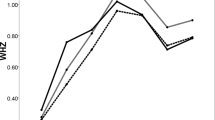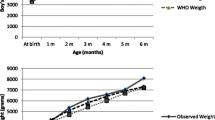Abstract
The smaller size of breast fed children in infancy and thereafter in malnourished and well-nourished populations has resulted in rushes to judgement that have been shown to be ill-advised. The reasons for the smaller size in malnourished populations is due to retaining the small and sickly child at the breast (reverse causality) and the consequent continuing sickliness of this breast fed child (negative confounding). Once the reverse causality and negative confounding have been taken into account breast feeding improves growth, at least through the second year of life. Thus prolonged breastfeeding should always be fostered, especially in malnourished populations. An exception remains when breast milk may transmit disease to the suckling child. In well-nourished populations the magnitude of the difference between breast fed and weaned children is much less than in malnourished populations, is observed to increase over the first year of life, but to have disappeared by the end of the second year. One may never-the-less be concernedthat complimentary feeding practices are not adequate for these children.
Access this chapter
Tax calculation will be finalised at checkout
Purchases are for personal use only
Preview
Unable to display preview. Download preview PDF.
Similar content being viewed by others
References
Brown, K., Dewey, K., and Allen, L., 1998, Complementary Feeding of Young Children in Developing Countries, World Health Organization, Geneva
Coutsoudis, A., Kubendran, P., Spooner, E., Kuhn, L., and Coovadia, H.M., 1999, Influence of infant-feeding patterns on early mother-to-child transmission of HIV-1 in Durban, South Africa: a prospective cohort study. Lancet 354:471–76.
de Onis, M., Gam, C., and Habicht, J-P., 1997, Time for a new growth reference. Pediatrics, 100:E8
Habicht, J-P., DaVanzo, J., and Butz, W.P., 1986, Does breastfeeding really save lives, or are apparent benefits due to biases? American Journal of Epidemiology 123:279–290.
J. Habicht, J-P., Victora, C.G., and Vaughan, J.P., 1999, Evaluation designs for adequacy, plausibility and probability of public health programme performance and impact. International Journal of Epidemiology. 28:10–18.
Marquis, G.S., Habicht, J-P., Lanata, C.F., Black, R.E., and Rasmussen, K.M., 1997a, Breast milk or animal-product foods improve linear growth of Peruvian toddlers consuming marginal diets. American Journal of Clinical Nutrition 66:1102–1109.
Marquis, G.S., Habicht, J-P., Lanata, C.F., Black, R. E., Rasmussen, K.M., 1997b, Association of breastfeeding and stunting in Peruvian toddlers: An example of reverse causality. International Journal of Epidemiology 26:349–356.
Pelto, G.H., 1981, Perspectives on infant feeding: decision-making and ecology. Food and Nutr. Bull. 3:16–29.
WHO, 1995, Physical Status: The Use and Interpretation of Anthropometry. Technical Report of a WHO Expert Committee, Geneva, World Health Organization, Geneva
Author information
Authors and Affiliations
Editor information
Editors and Affiliations
Rights and permissions
Copyright information
© 2002 Kluwer Academic Publishers
About this chapter
Cite this chapter
Habicht, JP. (2002). The Association Between Prolonged Breastfeeding and Poor Growth. In: Koletzko, B., Michaelsen, K.F., Hernell, O. (eds) Short and Long Term Effects of Breast Feeding on Child Health. Advances in Experimental Medicine and Biology, vol 478. Springer, Boston, MA. https://doi.org/10.1007/0-306-46830-1_17
Download citation
DOI: https://doi.org/10.1007/0-306-46830-1_17
Publisher Name: Springer, Boston, MA
Print ISBN: 978-0-306-46405-8
Online ISBN: 978-0-306-46830-8
eBook Packages: Springer Book Archive




